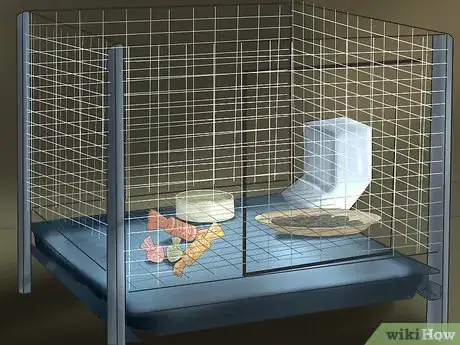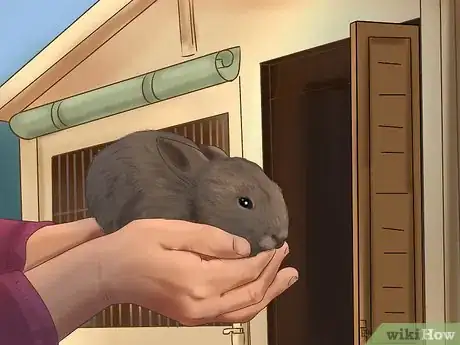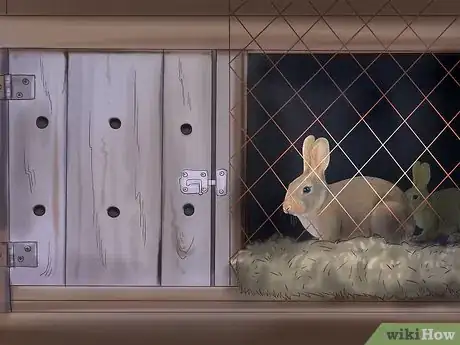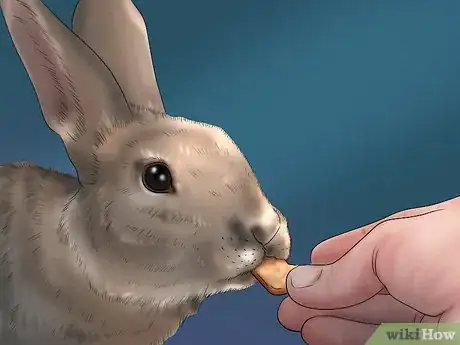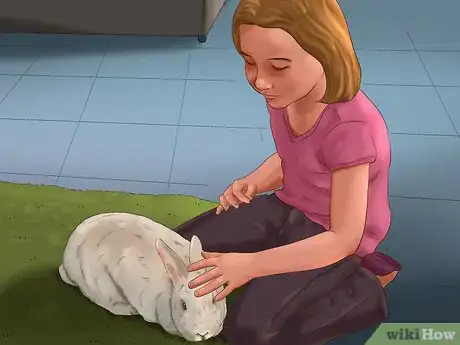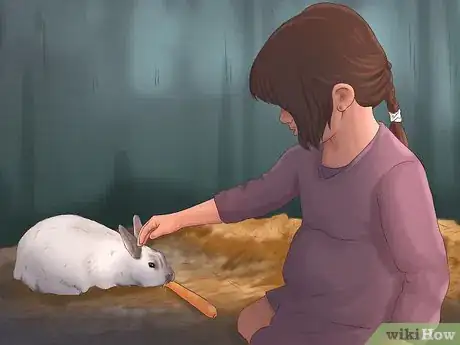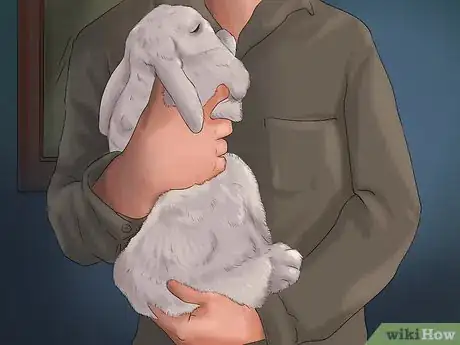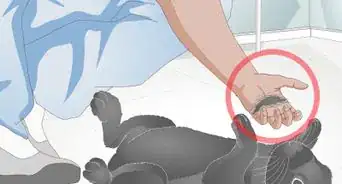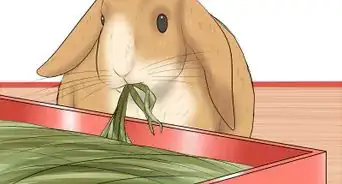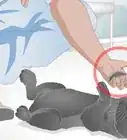This article was co-authored by Pippa Elliott, MRCVS. Dr. Elliott, BVMS, MRCVS is a veterinarian with over 30 years of experience in veterinary surgery and companion animal practice. She graduated from the University of Glasgow in 1987 with a degree in veterinary medicine and surgery. She has worked at the same animal clinic in her hometown for over 20 years.
There are 11 references cited in this article, which can be found at the bottom of the page.
wikiHow marks an article as reader-approved once it receives enough positive feedback. This article received 12 testimonials and 81% of readers who voted found it helpful, earning it our reader-approved status.
This article has been viewed 217,588 times.
Rabbits are popular pets. They're cuddly and can become very friendly. But don't be discouraged if you have a rabbit that is scared or cautious around you. Patience and careful handling will soon build her confidence. She'll be hopping around and greeting you in no time!
Steps
Preparing to Bring Your Rabbit Home
-
1Have all your supplies ready. You don't want to be fussing around looking for bedding or food bowls when you bring your rabbit home. She will be stressed after travel and desperate to retreat somewhere dark and quiet. Make sure you have a hutch that is large enough for an adult rabbit. It should be about two hops wide, three hops long, and tall enough for the rabbit to stand upright in. Have food, treats, water dispensers, toys, and straw ready.[1]
-
2Set up the hutch. Place the hutch in a quiet room that doesn't have noisy equipment such as a tumble dryer. Deep bed the hutch with straw or hay. Make a secluded sleeping area such as a sturdy wooden box stuffed with straw within the hutch.[2]
- Make sure other household pets (cats and dogs) can't sniff at the hutch. This will terrify the rabbit since dogs and cats are predators.
Advertisement -
3Create hiding places. Your rabbit will also appreciate having other hiding places around the house. Scatter several wide-diameter cardboard tubes or shoe boxes. This way, she has several places to hide or bolt if she gets scared while investigating.[3]
- Giving her hiding places doesn't teach her to hide. It just lets her do what feels natural. If she knows there are plenty of safe places available, then she'll be more likely to venture out in the first place.[4]
-
4Set your rabbit in the hutch. Quietly lift her from the carrier and place her in the hutch. Speak softly and handle her gently but firmly. If your rabbit seems nervous or anxious in the carrier, cover her with a towel before picking her up. The darkness of the towel (like being safe in a burrow) has a naturally calming effect which makes her feel safe and calm.[5]
- Be sure to support your rabbit's belly and hind legs with your hands when you move her to the hutch. Don't squeeze her.
-
5Give your rabbit some space. Don't handle your rabbit or lift her out of the hutch for the first 3 days after you bring her home. Let your rabbit become familiar and comfortable in her hutch. She may spend the first day hiding, but this is normal, so don't worry.[4] Once she gets used to the sounds and smells, she will start to venture out. She may run and hide when she first hears a noise, but will grow bolder when she realizes it's not a threat.
- Young rabbits are more curious than adults, so this process may be quicker for a youngster.
Approaching Your Rabbit
-
1
-
2Begin hand-feeding your rabbit. Once your rabbit has had a chance to settle in and a few days have gone by, start hand-feeding her. Start by sitting next to her cage and just talk to her in a calm voice. If she bolts, just keep quietly talking and wait for her to come to you. Open the door and offer her a tasty treat, like a dandelion. If your rabbit doesn't have the confidence to come up to the dandelion, set it halfway between the two of you.
-
3Let your rabbit become comfortable with you. When you feed or talk to your rabbit, rest your hand on the straw near the door. This way, she'll get used to your company while she eats.[4] Top up her food bowl and chat to her as you do. Since rabbits learn by experience, she will soon associate you with food (a good thing). This will help calm your rabbit.[7]
-
4Pet your rabbit once it shows interest in you. Once she's comfortable eating in your presence, you can start to gently touch her. Don't overdo it by trying to pick her up. She may become stressed and try to fight back. Instead, quietly reach inside the hutch and touch her back or flank. If she doesn't run away, gently stroke her.[8]
- Avoid putting your hand over the top of her head. Objects passing over the rabbit's head signal danger (such as a hawk flying over a rabbit). This is likely to make the bunny scared.[9] Make sure to approach her from the side or back.
-
5Pick up your rabbit. Once she's used to being stroked in her hutch, you can try picking her up. Sit on the ground, lift the rabbit out and put her on your lap on ground level. Keep some dandelions handy so that she has something tasty to nibble to distract her. Keep the session short, about one minute to start with. This way she won't start to panic. With practice you can keep your rabbit out longer and longer.[10]
- You should also keep a towel nearby in case your rabbit gets distressed. Then you can cover her with a towel. This will calm her. You can also scoop her up in the towel, which means you are less likely to get scratched if she panics.[9]
-
6Let your rabbit roam.[11] Once your rabbit is used to your presence and being picked up, you may want to let her roam in the house. Always supervise her, and start with one small room so that she doesn't feel overwhelmed. Check the room first and make sure there are no gaps for her to hide and get stuck in. Make sure there are no electrical cables for her to chew.[12]
- Rabbits will chew anything, so be alert and remove anything you don't want damaged.
-
7Lie on the floor while your rabbit explores. While your rabbit checks out her new environment, you should lie flat on the floor. This makes your height less intimidating for your rabbit and lets her sniff and investigate without feeling threatened. A good tip is to keep a treat in your pocket or hand, and reward her brave behavior with a snack.[4]
- Keep the sessions short and sweet at first, no longer than 10 - 15 minutes. This way your rabbit won't get overtired.
Expert Q&A
-
QuestionWhat should I do if my small rabbit doesn't eat at first?
 Pippa Elliott, MRCVSDr. Elliott, BVMS, MRCVS is a veterinarian with over 30 years of experience in veterinary surgery and companion animal practice. She graduated from the University of Glasgow in 1987 with a degree in veterinary medicine and surgery. She has worked at the same animal clinic in her hometown for over 20 years.
Pippa Elliott, MRCVSDr. Elliott, BVMS, MRCVS is a veterinarian with over 30 years of experience in veterinary surgery and companion animal practice. She graduated from the University of Glasgow in 1987 with a degree in veterinary medicine and surgery. She has worked at the same animal clinic in her hometown for over 20 years.
Veterinarian It's very important that your rabbit continue to eat, because otherwise, their gut goes to sleep (gut stasis), a condition which makes them very ill. If the rabbit hasn't eaten for 12 - 24 hours, contact a vet immediately. The latter can give an injection to stimulate the gut and keep it working. To reduce the risk of the rabbit refusing to eat, provide a hide with food inside and leave the rabbit in peace for hours at a time to help her feel safe enough to eat. Rabbits prefer to eat at dawn and dusk, so it also helps to have low lighting in the room where the hutch is.
It's very important that your rabbit continue to eat, because otherwise, their gut goes to sleep (gut stasis), a condition which makes them very ill. If the rabbit hasn't eaten for 12 - 24 hours, contact a vet immediately. The latter can give an injection to stimulate the gut and keep it working. To reduce the risk of the rabbit refusing to eat, provide a hide with food inside and leave the rabbit in peace for hours at a time to help her feel safe enough to eat. Rabbits prefer to eat at dawn and dusk, so it also helps to have low lighting in the room where the hutch is. -
QuestionI have visited the rabbit every week. Should I still follow the guideline given in the article?
 Pippa Elliott, MRCVSDr. Elliott, BVMS, MRCVS is a veterinarian with over 30 years of experience in veterinary surgery and companion animal practice. She graduated from the University of Glasgow in 1987 with a degree in veterinary medicine and surgery. She has worked at the same animal clinic in her hometown for over 20 years.
Pippa Elliott, MRCVSDr. Elliott, BVMS, MRCVS is a veterinarian with over 30 years of experience in veterinary surgery and companion animal practice. She graduated from the University of Glasgow in 1987 with a degree in veterinary medicine and surgery. She has worked at the same animal clinic in her hometown for over 20 years.
Veterinarian Yes. It's great that you've "broken the ice" and started getting the rabbit used to you. However, changing locations and going into a new hutch is changing everything the rabbit is familiar with, and this will naturally make her more cautious. Give her a day or two to settle in, and then follow the advice in the article. Hopefully, as she already knows you, the process should be quicker.
Yes. It's great that you've "broken the ice" and started getting the rabbit used to you. However, changing locations and going into a new hutch is changing everything the rabbit is familiar with, and this will naturally make her more cautious. Give her a day or two to settle in, and then follow the advice in the article. Hopefully, as she already knows you, the process should be quicker. -
QuestionHow can you tell if a rabbit doesn't like you?
 Pippa Elliott, MRCVSDr. Elliott, BVMS, MRCVS is a veterinarian with over 30 years of experience in veterinary surgery and companion animal practice. She graduated from the University of Glasgow in 1987 with a degree in veterinary medicine and surgery. She has worked at the same animal clinic in her hometown for over 20 years.
Pippa Elliott, MRCVSDr. Elliott, BVMS, MRCVS is a veterinarian with over 30 years of experience in veterinary surgery and companion animal practice. She graduated from the University of Glasgow in 1987 with a degree in veterinary medicine and surgery. She has worked at the same animal clinic in her hometown for over 20 years.
Veterinarian Rabbits don't think in terms of "like" or "dislike," but they do know if they feel confident or fearful. A rabbit you perceive as "liking" you is one that trusts you and feels confident around you. Signs of this include approaching when you call, accepting food from your hand, being relaxed when you stroke her, and staying out in the open when you are around. A rabbit you perceive as "disliking" you is one that is fearful or anxious. Signs of this include hiding, refusing to leave the hide, thumping a back leg, shaking or tremors when held, and grinding her teeth.
Rabbits don't think in terms of "like" or "dislike," but they do know if they feel confident or fearful. A rabbit you perceive as "liking" you is one that trusts you and feels confident around you. Signs of this include approaching when you call, accepting food from your hand, being relaxed when you stroke her, and staying out in the open when you are around. A rabbit you perceive as "disliking" you is one that is fearful or anxious. Signs of this include hiding, refusing to leave the hide, thumping a back leg, shaking or tremors when held, and grinding her teeth.
Warnings
- Make sure you watch your bunny while it explores , if you don't it can get lost.⧼thumbs_response⧽
- Make sure you support your bunny's feet and legs when you hold her. Otherwise, she can scratch you or feel uncomfortable.⧼thumbs_response⧽
References
- ↑ http://www.rabbithaven.org/supply-list/
- ↑ https://www.petmd.com/rabbit/care/whats-perfect-rabbit-cage-setup
- ↑ https://www.rspca.org.uk/adviceandwelfare/pets/rabbits/behaviour/enrichment/hidingplaces
- ↑ 4.04.14.24.34.44.5Why Does My Rabbit..? Anne McBride. Publisher: Souvenir Press
- ↑ https://www.rspca.org.uk/adviceandwelfare/pets/rabbits/company/handling
- ↑ https://rabbit.org/faq-aggression/
- ↑ http://www.bio.miami.edu/hare/shybun.html
- ↑ https://myhouserabbit.com/rabbit-behavior/building-a-relationship-with-your-rabbit/
- ↑ 9.09.1Textbook of Rabbit Medicine. Frances Harcourt-Brown. Publisher: Butterworth-Heinemann
